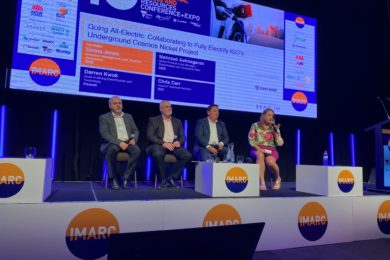An industry panel discussion on the potential of electrifying IGO’s Cosmos underground nickel project at IMARC 2023 today highlighted the opportunities, risks and complexities associated with ‘greening’ a brownfield mining project at the moment.
This study was to see experts from Perenti and ABB work side by side with IGO to provide a pathway for the optimum design of mine electrification at Cosmos. All aspects of electrification were to be considered in the study, including:
- Mine design optimisation for electric operations;
- Production and operating philosophy;
- Fleet selection;
- Power distribution and electrical infrastructure design;
- Electrification system and battery management;
- ESG and safety impact analysis; and
- Cost modelling of both capital and operating expenditure.
At IMARC today, on the ‘Going All-Electric: Collaborating to Fully Electrify IGO’s Underground Cosmos Nickel Project’ panel discussion, chaired by Emma Jones, Innovation Management Lead, Southern Hemisphere, GHD, all three companies had representatives on stage to flesh out some of these bullet points, with the result being a fascinating discussion on implementing what is still a revolutionary concept.
The Cosmos study is split into three distinct parts with the companies currently half way through the process.
Both Chris Carr, Head of Technical Services at IGO, and Darren Kwok, Head of Mining Electrification and Technology, Perenti, admitted that the task at hand was highly complex.
Carr said the process would be much easier in a greenfield mine, with the potential ventilation and refrigeration cost reductions that would come with introducing electric machines likely to “pay” for the new equipment required.
At the same time, he acknowledged that the networks and communication would need to be improved to effectively run an all-electric mine to allow operators to know what vehicles had what state of charge and deploying these machines in the optimal way.
“This could potentially see whole sites use Wi-Fi or 5G for better data transmission,” he said. “At the same time, we would know where every vehicle is and where every vehicle is going, providing the opportunity for ‘true’ collision avoidance.”
Kwok said there was likely to be a “flow-down effect” when electrifying equipment, which would have an impact on how mines plan, schedule and operate. “We need a holistic view of a mine,” he said, explaining that “just in time” mining would not work in an all-electric operation where energy management is a key concern.
Kwok added: “We also have to link the fleet together with the rest of the operations – that is the secret sauce here.”
Mehrzad Ashnagaran, Global Product Line Manager – Electrification and Composite Plant, ABB, said any mining company looking to fully electrify their mines needed to recognise that they were working with “immature technology” that cannot meet all of their requirements.
“The design of an all-electric mine is different to the vision we originally had,” he said. “This is why we need to break the process down into manageable projects for a phased approach that can allow customers to start decarbonising now.”
This is where the company’s eMine™ approach comes in, providing a roadmap of solutions on the way to longer-term electrification goals.
“In reality, the solution we are offering today may not be the same one we offer companies in five to 10 years’ time,” he added.
There was also an engaging exchange on the risk management associated with embarking on this exercise.
Ashnagaran said, for ABB, the Cosmos study and other all-electric projects the company is working on would see its vendor agnostic and interoperable approach tested and scrutinised.
“The whole eMine philosophy, however, is that no-one can go on such a journey alone; we need to collaborate with partners,” he said.
Kwok said the study allowed the service provider to learn and understand the terms of how electrified mining can practically work.
“We, at Perenti, already understand what ‘good’ looks like [from an operating perspective]…and we also understand what change looks like at a mine site,” he said, adding that the company already has electric machine data to pull into such studies.
Carr said building ‘the electric mine’ is both a risk and an opportunity, with the mining company prepared to financially back most of the expense associated with this as it had, potentially, the most to gain from a successful outcome.
He also added a bit of wider IGO context to reinforce the point.
“At IGO, we invest A$70 million ($44.5 million) a year on exploration, putting drills into the ground,” he said. “Not all of those holes are deemed a success, but they allow us to keep building our knowledge,”
The same is true for this all-electric Cosmos study.
“Regardless of the outcome, we will learn a lot,” he said. “We are driven to be the ‘first to be first’ here; first to be second simply does not work for us.”










